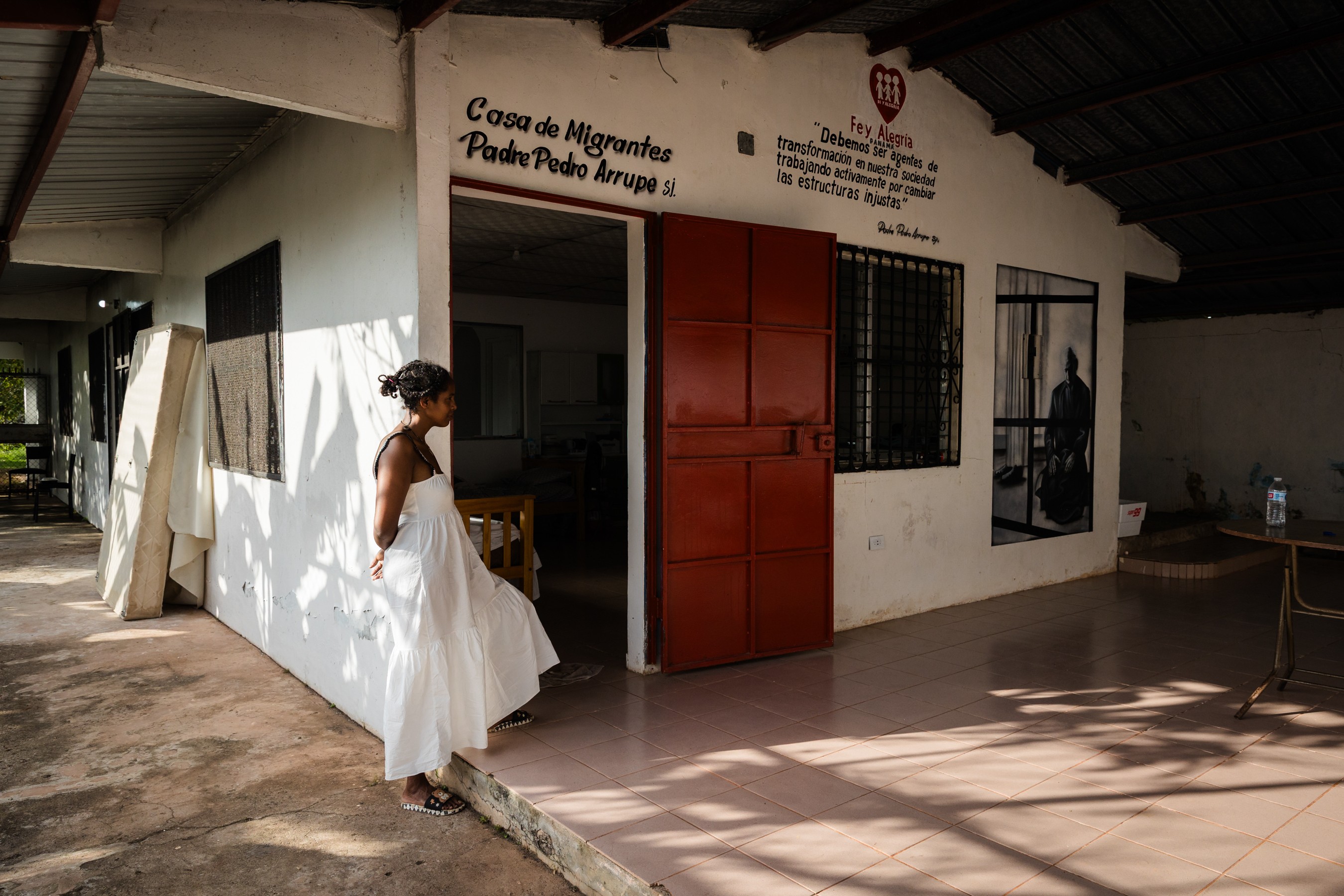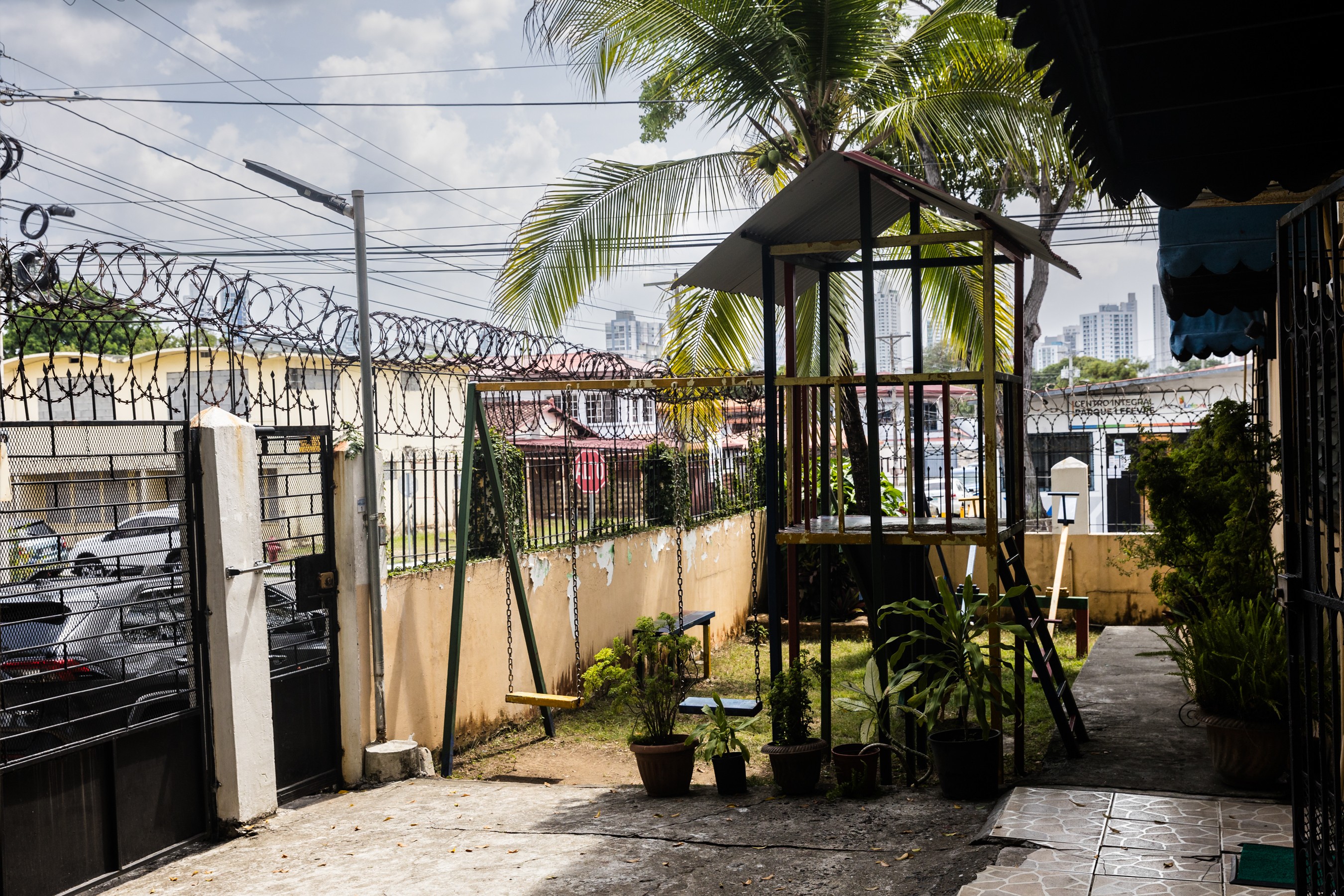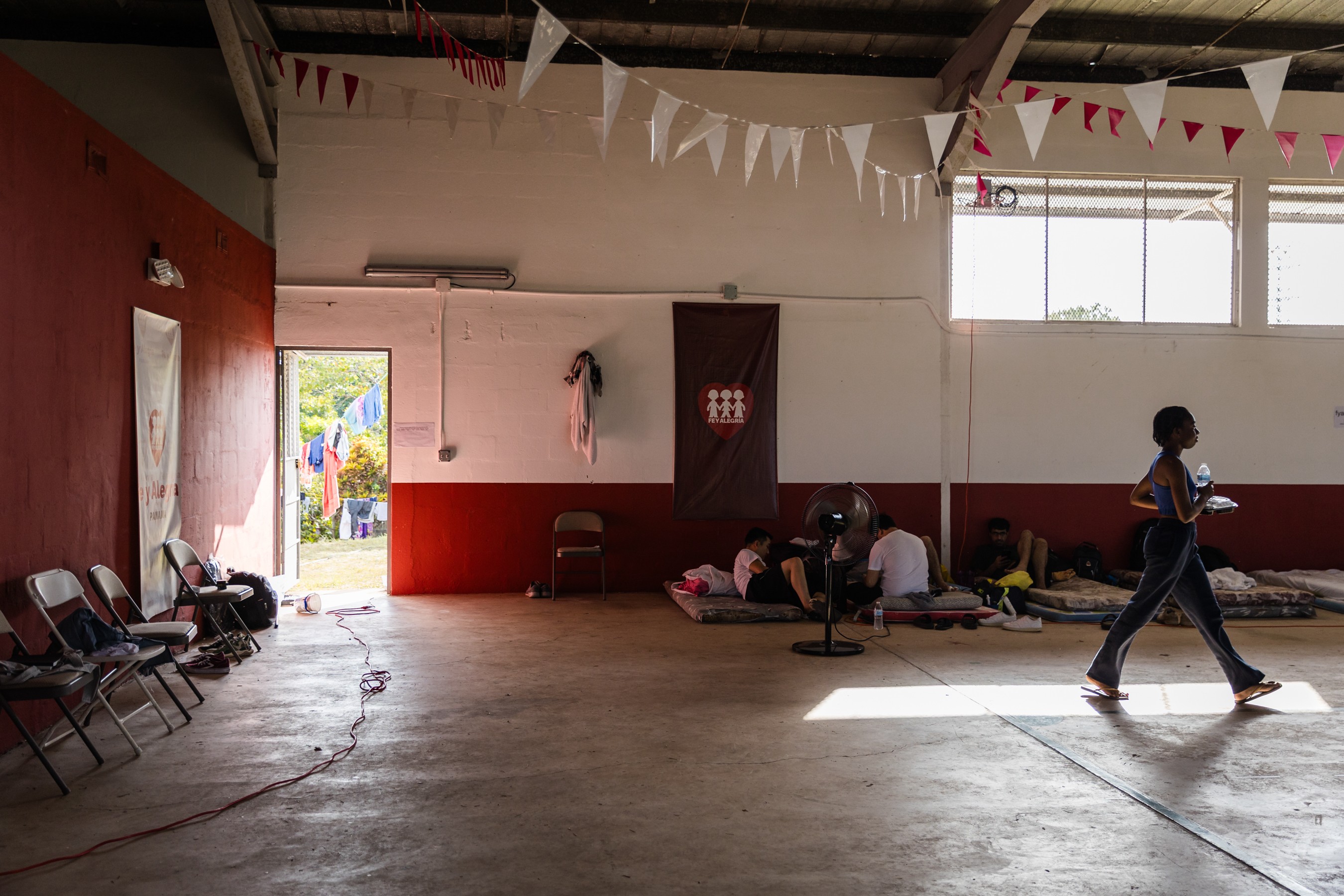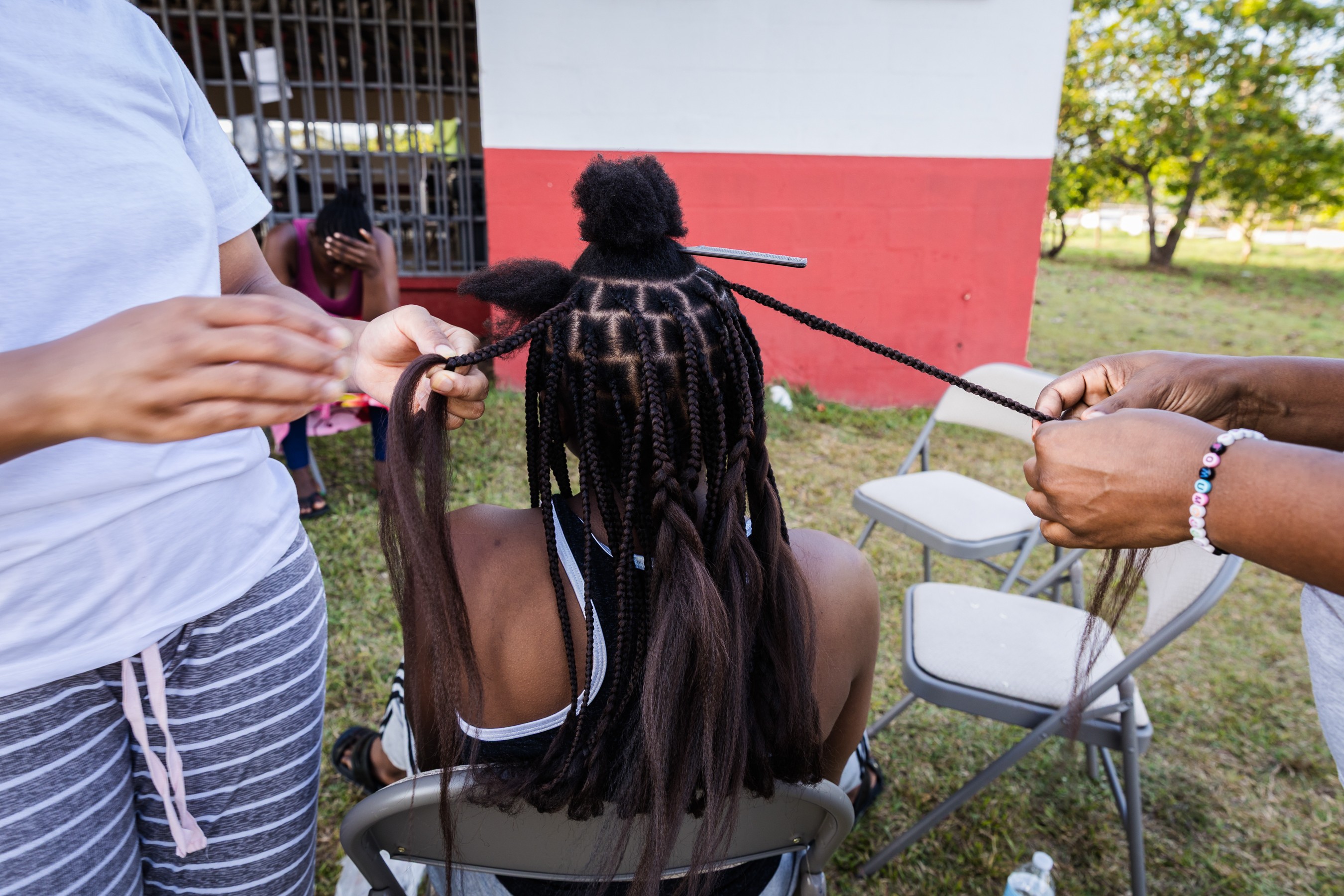Photographs by Tarina Rodriguez
The Decapolis Hotel advertises “spacious suites & ocean views” in a business area in Panama City. The glass tower is also one of the few hotels in the city that can accommodate 299 people on short notice. When three planes carrying non-Panamanian deportees arrived in mid-February from the United States, the Decapolis redirected its guests to partner hotels and turned over its trendy lobby to armed security personnel, who ensured that no one could get in or out.
Comfortable rooms were repurposed as prison cells, with police officers stationed in the hallways to ensure that people left only for meals. Still, the migrants managed to communicate with journalists by holding written messages up to the windows. One Iranian woman wrote HELP US in lipstick on the glass.
These were the first migrants Donald Trump sent away in a third-country deportation agreement. Some had intended to apply for asylum in the United States—a right enshrined in U.S. and international law. But Trump has suspended the asylum process as part of his immigration crackdown. Many of the 299 people shipped off to Panama—some without even knowing where the planes they’d boarded were bound—now find themselves in a dangerous purgatory. Some don’t feel they can return to their countries of origin, but also don’t wish to stay in Panama, or don’t trust that their asylum pleas will be given due consideration there.
Inconveniently, the U.S. planes arrived in Panama at a moment when the country’s leader was keen on reducing immigration. President José Raúl Mulino campaigned last year on building a Trumpian border wall. But when Trump started threatening to seize the Panama Canal, Mulino sought to placate him, even if that meant putting Trump’s anti-immigration agenda before his own. Mulino sought to reassure the public that the migrants’ stay in Panama was essentially a long layover on the way to deportation: “We hope to get them out of there as soon as possible.” Government officials emphasized that the migrants were “in transit,” just like the ships passing through the Panama Canal. But Mulino has said on other occasions that international law would be respected, and that no one would be forced to return to a country where they didn’t feel safe.
In mid-March, I went to Panama to find out what might become of the migrants who were still there—those who, politicians kept saying, are in transit, but who seem to have nowhere else to go.


In the early days after the planes’ arrival, some of the migrants told me, staffers from the United Nations International Organization for Migration showed up at the hotel and paid each person a visit. According to those I spoke with, the IOM staffers told them that they could either fly home right away on a commercial airline or wait to be deported by the Panamanian authorities. More than half of the migrants signed repatriation documents and flew to their countries of origin, such as India and Uzbekistan.
The Panamanian authorities and the IOM called these returns “voluntary.” “IOM does not carry out forced returns or coerce people to voluntarily depart,” an IOM spokesperson told me. “Our role is limited to assisting those who choose to return so they may do so safely.”
But how well the migrants understood their options is not clear. A Chinese man who identified himself as Xu told me that a woman he’d met at the hotel had texted him from the Istanbul airport. (Xu asked me to withhold his full name so Chinese officials wouldn’t know his location.) She told him that she had agreed to repatriate only because she thought she had no choice. When she landed in Istanbul for a layover, she refused to board the connecting flight to China. Then she learned that the people who hadn’t signed the repatriation documents had stayed in Panama. She asked Xu if he could talk with someone to arrange her return. Xu wasn’t able to help her, and the last time I talked with him, he said that the woman had spent five days in the Istanbul airport before making it to another country, and that she didn’t want to talk with reporters. (The IOM spokesperson declined to comment on the woman’s case.)
Staff from Panama’s National Refugee Office visited the Decapolis and invited the 100 or so remaining migrants to apply for asylum. But the government’s public messaging had given them little reason to believe the offer was sincere. On February 19, soon after the migrants landed in Panama, Security Minister Frank Ábrego had declared at a press conference: “At no point will Panama offer asylum to any of these people.” Hardly any of the migrants made claims at first.
Still, five women from Cameroon and one from Ghana decided to take advantage of the opportunity. “America doesn’t want us and sent us here,” one of them told me. “Let’s stay here.” Asylum decisions usually take years, but an initial decision as to whether their cases were eligible to move forward would take about two weeks from the asylum hearing, they were told. In fact, it came in two days: All six applications were refused. (The national refugee agency, known by its Spanish acronym as ONPAR, did not respond to my request for interviews or comment.)
One of the women was a 32-year-old who fled Cameroon amid fighting last November. She asked me to withhold her name so that assailants in her home country wouldn’t be able to locate her. In her asylum hearing, she said that police officers had entered her house and raped her in front of her siblings, and that the police had burned her whole village. But she also said she hoped to work in Panama, because she was “the only one able to send money to her family.” In the refusal letter, the agency argued on the basis of these words that she was an economic migrant and therefore not in need of asylum.
She and the other remaining migrants were transported from the Decapolis to a camp in San Vicente, in the Darién Gap, the same jungle many of them had crossed by foot on their journey to the United States. They spent three weeks there, amid filth and mosquitos, in unrelenting heat—and without access to lawyers or phones, according to the migrants I spoke with as well as a Human Rights Watch report. Then Panamanian officials came and told them they were free to leave.
They were given permits that allowed them to live, but not work, in Panama for 90 days. All they had to do was sign a document certifying that the Panamanian authorities had treated them well and another agreeing to the terms of the 90-day permit. According to a lawyer who has worked with this group since, some at first refused to sign—they had questions about what the permit entailed—but were pressured into doing so under threat of deportation. (Panama’s security ministry declined to comment on the claim that migrants were pressured to sign.) Then they boarded buses that would take them back to Panama City.
The first two buses dropped the migrants off in the parking lot of a shopping mall late on March 8. UNICEF staffers were there waiting for the families with children, to bring them to a hotel. The rest were on their own. Some had been in touch with Caitlyn Yates, a blond, bespectacled American who’d moved to Panama as a doctoral student to study the migration of Asians and Africans through the Darién Gap to North America. When Yates found out that some of her research subjects were on their way to Panama City, she messaged the Panamanian lawyer Victor Atencio, who was also following the migrants’ situation closely. Yates and Atencio arrived at the parking lot less than an hour after the migrants, ready to help.
The migrants didn’t know it, but Atencio was probably the reason they’d been allowed to leave the Darién Gap. A robust, buttoned-up man of 50, he had read about the migrants in The New York Times. He’d filed a habeas corpus petition that the Panamanian government had ignored. Then he sued Panama before the Inter-American Commission on Human Rights, asking the court to set some “precautionary measures”: for the migrants to be set free, communication with lawyers to be allowed, and deportation to be deferred. Several legal organizations, including the Global Strategic Litigation Council, joined the suit.
The day before Panama’s deadline to respond to the court, it released the migrants and gave them the 90-day permits. According to GSLC’s lawyers, the Panamanian government claimed that it had not mistreated the migrants or held them incommunicado. The human-rights commission eventually declined to set the precautionary measures, but reminded Panama to follow international law.
By the time the buses arrived that March night, only a chicken joint and a McDonald’s remained open in the mall’s food court. Yates bought everyone a meal as Atencio called hotels in the city to find one with availability. Together, they stopped taxis one by one, until there were enough to go to the hotel in a caravan. Samin Haider, a 22-year-old Pakistani, would later describe that night to me as the first time he’d felt hope after arriving in Panama. Yates and Atencio weren’t the only ones who showed the migrants kindness. There was the McDonald’s cashier who offered them free ice cream, the mall employee who allowed the food court to stay open late, and the taxi drivers who didn’t want to be paid.
In mid-March, I visited Hogar Luisa, a two-story house owned by a Catholic charity that Yates had approached and that now sheltered about a dozen of the migrants. Many more were sleeping at a school gym repurposed into a camp by Fe y Alegría, another Catholic charity Yates had enlisted. The migrants were finally free to come and go as they pleased, but so were reporters. They were a bit tired of us.


“Why do you ask so many questions?” a Nigerian woman asked me, laughing. “We all have the same story.” She asked me to withhold her name out of fear of reprisals against her son, who is still in Nigeria. She said she descends from a long line of priestesses in the local religion of her home region, but she didn’t want to be one herself. Instead, she married a Christian and converted to Christianity. When her grandmother, the “priestess of the shrine,” found out, she pledged to kill her in punishment.
An Iranian woman I met had also converted to Christianity, in a Muslim country where apostasy can be punishable by death. (She asked to remain anonymous to protect her Christian relatives in Iran, and in case she is forced to return.) She’d owned a gym and was married to an electrical engineer. The police learned that the couple were hosting Christian services at their house, and so they’d fled.
A young Pakistani man named Syed Saqlain Badshah told me he’d led student protests in Parachinar in 2017. He’d been hiding from the Pakistani Taliban ever since. A woman named Dora Zhou didn’t want to tell me why she and her two teenage daughters had left China. “It’s too painful,” she wrote on her phone. “I had no choice but to leave.”
I spent perhaps the most time with a 21-year-old woman from Afghanistan who asked to be identified only by her middle name, Serwarah, out of fear of retaliation against her relatives still in the country. She grew up in Maymana, a small city in Faryab province, near the country’s northern border with Turkmenistan. As a girl she’d read Napoleon Hill’s bootstrapping best seller from 1937, Think and Grow Rich, and she’d planned to study accounting in college and launch her own clothing brand. That was before the Taliban took over. Then those avenues all closed, and her grandmother told her that a Talib with two wives who was many decades older had requested her hand in marriage. She’d known this man all her life—he was her mother’s distant cousin—and she wondered when he’d begun thinking of her that way.
To escape this marriage, Serwarah fled Afghanistan in 2021, when she was 17. She settled first in Iran. From there, she tried to cross into Turkey by foot, only to be stopped at the Turkish border and raped by a Turkish border-police officer. She was sent back to Iran. In 2023, she was accepted to Near East University, in Northern Cyprus, one of the few places in Europe where Afghan nationals can get visas on arrival. But officials at Ercan Airport refused to admit her. She decided to make her way to the United States.
Serwarah acquired a fake visa for Brazil, where she landed in November 2024, and from there she took buses, trekked the Darién Gap, and took more buses all the way to the United States. Somewhere along the way, she learned that in her absence, the Talib had requested to marry her little sister. She thought about returning and marrying him so that her sister would be spared. But her favorite uncle told her over the phone, If you come back, the Taliban will stone you to death. And he’ll still marry your sister.
The night Serwarah left Afghanistan, her sister had insisted she take one thing with her: their great-grandmother’s ring, a ruby surrounded by tiny Afghan emeralds. It’s the only possession she has kept—she attached it to her bra strap so it wouldn’t get lost or stolen and told herself she’d put it on her finger when she reached America and applied for asylum.
When I met her in Panama, Serwarah was living in a shelter, but otherwise seemed in every way like the 21-year-old she was: She spent her days texting her boyfriend, an Afghan she’d met working in a perfumery in Iran, and taking the bus to the mall to buy makeup with money her uncle sent.
The heads of the charities hosting the migrants have years of experience. Panama is, after all, home to the Darién Gap, the treacherous stretch of jungle that separates South and Central America, which thousands of migrants have crossed by foot. But the migrants sent by plane from the United States presented challenges that even these professionals had never encountered, they told me.
Father Marco Tulio Gómez, the director of Fe y Alegría, and Jorge Ayala, of Hogar Luisa, normally work alongside government agencies. Both charities reached out to officials to talk about getting work permits for the migrants, and both told me that their calls went unanswered. The Apostolic Nunciature to Panama, the Pope’s diplomatic mission in the country, also tried establishing contact with the authorities to no avail. Ayala told me he thought the Panamanian government might be putting off any decisions until it knows whether the Trump administration plans to send more migrants.
Father Gómez told me he was accustomed to working with migrants who were on their way north. “They still had a goal,” he said. Many of those flown to Panama from the United States, by contrast, seem not to fully understand that America is, for now, not an option. Ayala is still trying to get them work permits, but he told me that most of them don’t really want to stay in Panama. He worried that they would try their luck again crossing the U.S. border. “Between eyebrow and eyebrow, all they have is thoughts of going back,” Ayala said. “All they want is America. All they have is Panama.”

The group of lawyers that joined Atencio’s lawsuit went on to file another lawsuit over Panama’s treatment of migrants. The Inter-American Commission on Human Rights could take years to make a decision on it. The new lawsuit charges that Panama has not respected the rights of the migrants to seek asylum. Among other claims, it alleges that the Panamanian police obstructed some migrants from applying, and that those who did apply—the six women from Cameroon and Ghana—had no way to seek legal counsel, received immediate denials, and were told by Panamanian authorities not to appeal. “Everything indicates that the process sought to discourage access to protection rather than guarantee it,” Silvia Serna, one of the lawyers on the suit, told me.
After the lawsuits were filed—the lawyers suggest because they were filed—those migrants who wished to seek asylum were better able to do so. At least three more have been denied, and no one has received a positive answer yet. But the national refugee agency has called some migrants back for interviews, suggesting that their cases may be receiving appropriate consideration.
Whether or not they can, however, very few of the migrants seem to want to apply for asylum in Panama. Ayala knows of only nine between the two shelters who have done so. Those I spoke with told me that they thought their claims would be pointless, and that anyway, they didn’t want to live in Panama.
“I don’t trust anyone in Panama,” Narges, a reclusive Iranian woman, said when I asked her why she didn’t want to apply for asylum. (Another Christian convert, she asked me to omit her last name to protect her relatives in Iran.)
“But do you have any other place to go?” I pressed.
“I don’t trust anyone in Panama,” she said again.
After the 90-day permit expires, Panama may well deport those who never sought asylum. “The fundamental framing of this permit was as a deferred deportation,” Ian Kysel, a co-founder of the Global Strategic Litigation Council, told me. And yet, most of the people I spoke with in March either didn’t understand this or had other plans they didn’t share with me. When I spoke with migrants still in the shelters just this week, they told me that dozens had left since I was last there. Some, Serwarah texted me, have made it to Mexico.
The last day I went to the Fe y Alegría camp was sunny, with a nice breeze. Nigerian and Ghanaian women were braiding one another’s hair under a tree, blasting Afrobeat. Eritreans and Ethiopians were playing Uno on plastic dining tables. Chinese kids had come to visit from the hotel and were running around, hiding behind some of the mattresses on the gym floor.
Serwarah wasn’t there—she was staying at Hogar Luisa—but other Afghans had gathered around her closest friend in Panama, Suraiya Hussaini, a 25-year-old whose brother, Ali, had stayed behind in an ICE detention center and was now being deported to Afghanistan. As everyone around her looked forward to movie night, Suraiya looked numb. Serwarah, who heard the news from other Afghans, kept calling to ask for updates, but Suraiya had stopped answering her phone. Anxieties about deportation, which hadn’t troubled Serwarah and other Afghans for a few days, had returned with vivid intensity, she later told me.

Before I left Panama, I attended one of President Mulino’s Thursday press conferences in Palacio de las Garzas, the presidential office and residence. I asked him whether the migrants would be able to stay in Panama once their 90-day humanitarian permits expired in June.
“I haven’t considered this,” Mulino answered. “The idea is that they leave before.”
“And they do want to leave,” he added. “They come from countries very, very far away.”
The post ‘All They Want Is America. All They Have Is Panama.’ appeared first on The Atlantic.




